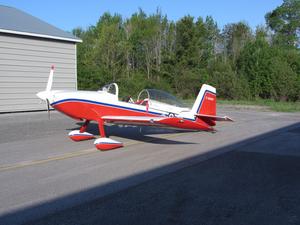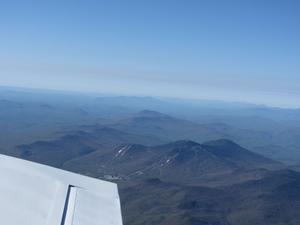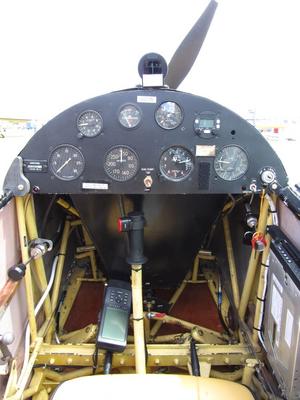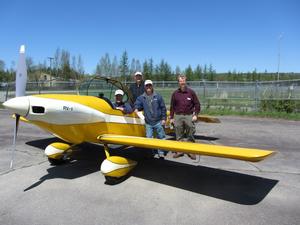Yesterday all the pieces finally fell into place to bring the RV–1 into Canada. I thought we may be able to do this on Monday, but the tach cable broke while the aircraft was enroute to Nashua, NH Sunday afternoon, and it took until Wednesday to get the aircraft serviceable again.
 Mark Richardson flew me to Bangor, ME in his beautiful RV–8, while Bob DiMeo was flying the RV–1 there too.
Mark Richardson flew me to Bangor, ME in his beautiful RV–8, while Bob DiMeo was flying the RV–1 there too.
 The weather was perfect, with clear skys. We were surprised to see snow still visbile in some ski runs at the Jay Peak ski resort in northern Vermont.
The weather was perfect, with clear skys. We were surprised to see snow still visbile in some ski runs at the Jay Peak ski resort in northern Vermont.
Bob and I did the official handover, then I did some taxiing around a short flight, with several stop and go landings.
 The RV family of designs has come a long way from the original RV–1. The RV–1 cockpit is very cramped, with not nearly enough leg room, very poor access to the flap lever and pitch trim lever, and no place to store anything. There is no real cockpit floor, so anything that is dropped may disappear in the maze of steel tubes.
The RV family of designs has come a long way from the original RV–1. The RV–1 cockpit is very cramped, with not nearly enough leg room, very poor access to the flap lever and pitch trim lever, and no place to store anything. There is no real cockpit floor, so anything that is dropped may disappear in the maze of steel tubes.
The rudder and brake pedal geometry is poor. The aircraft requires a large right rudder input during the take-off roll, and I found it very difficult to make that large rudder input without also getting a bunch of right brake. The aircraft is a bit more sensitive directionally than other RVs I have flown, so care must be taken to make small rudder inputs while on the ground. I had been advised to wear my smallest shoes, which I did, but I should acquire something with even thinner soles for my next RV–1 flight. Ross Keirstead used slippers for his flight - perhaps that is the answer.
Airborne, the ailerons feel much like newer RVs. The elevator has more friction, as the control is via cable, not the pushrods used from the RV–3 onwards. The pitch trim tab is quite small, and the total trim authority is not adequate in either direction. You run out of nose down trim at 140 mph IAS when accelerating and you have to hold some aft stick force during final approach even will full nose up trim.
The prop is underpitched. Craig Catto, from Catto Propellers took a guess on what pitch would be needed, but he missed the mark. He had never done a prop before for an RV–1, so I’m certainly not criticizing. The aircraft accelerates and climbs very well at low speed. Departing Bangor, I took off first, on the assumption that Mark, in his 200 hp, fixed-pitch RV–8 should have no problem catching the 135 hp RV–1. Mark took off about 20 seconds after me, and he was unable to catch up unitl I leveled off at 5500 ft. As soon as I leveled off, I had to pull the throttle well back to keep the rpm under control. I cruised at 2500 rpm, which gave about 125 kt TAS, according to Mark (the RV–1 airspeed overreads in cruise).
I had one event of note - as we approached St. Stephen, NB, the lap belt came undone. It took quite a bit of fumbling around to retrieve the two lap belt pieces from below the seat, and get the buckle set again. I gave up on getting the shoulder harness reattached.
I was expecting that Canada Customs would give us a grilling about whether the aircraft was being imported, and thus we owed a pile of taxes on it, but they never even showed up to talk to us. Mark and I are both CanPass members - that program is worth the $40 application fee.
 Several NB RVers were waiting for us when we got to St. Stephen. Ross Keirstead, Don Bertelsen and Joe Hine were all there. Here you see Ross in the cockpit, then Mark, Don and myself.
Several NB RVers were waiting for us when we got to St. Stephen. Ross Keirstead, Don Bertelsen and Joe Hine were all there. Here you see Ross in the cockpit, then Mark, Don and myself.
After the handover to the NB RV crowd, Mark flew me back to Carp. We had a great tailwind on the way to Bangor in the morning, but we paid the price on the way home with headwinds of 20 to 25 kt. Mark refused to accept any money for RV–8 fuel. Mark is one of the owners of the HogsBack Brewing company - if you are ever in Ontario, be sure to try some of their great beer, available on tap at many popular establishments, and in bottles (soon cans) at select LCBOs. It’s the least you can do to pay back Mark. Your taste buds will thank you.